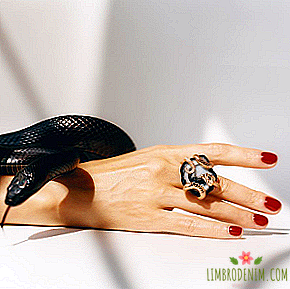Worse than stealing: Why is it time to stop looking for plagiarism in fashion
In 1989, the underground designer Dapper Danknown for his love of hip-hop get-together and logomania, he captured the American athlete Diane Dixon in a mink coat of his own design - with voluminous sleeves decorated with the abbreviation LV. After 28 years, a similar thing appears in the Gucci cruise collection, and the Internet literally explodes in memes: is it plagiarism or a thin homage of the 80s legend?
Alessandro Michele himself, the creative director of Gucci, assures that the famous Dapper Dan coat only served as a source of inspiration for him - there is no direct borrowing of speech. Still, it’s hard to get rid of the feeling of deja vu: why shouldn’t a brand simply collaborate with a designer by inviting him to rethink his hits in the context of modern fashion?

A couple of weeks before the show at the Miho Museum, near Kyoto, another major industry player Louis Vuitton presented his cruise collection; The creative director of the house, Nicolas Ghesquière, worked on it together with the most important designer of the 20th century, Kansay Yamamoto. The stripes that create the optical illusion, like on David Bowie's costume for the Aladdin Sane tour, were inspired by Japanese calligraphy prints - all this reads references to the man’s own collections that anticipated the wave of popularity of Japanese designers in Paris. However, Louis Vuitton doesn’t hide it: Gheskyer calls himself a fan of Yamamoto, while the Japanese artist himself sat at the front row show.
The question of the secondary nature of modern fashion is raised regularly in the industry. Starting with a frank plagiarism, like a sensational story about how Zara used the work of LA-based artist Tiusdie Bassen without her knowledge, to numerous catwalk collections of big and small brands, evoking thoughts in the spirit of "somewhere we have already seen it." To draw the line between frank copying and notorious inspiration is becoming increasingly difficult - while talking about who used this or that print or cutting sleeves before, a simple man in the street is not particularly worried.
Famous journalist Angelo Flaccavento wrote more than once that we live in the post-production era - the term was once introduced by curator and art critic Nicolas Burrio. Simply put, the whole of modern culture from fashion and design to music and art is the processing of existing or existing things. It is almost impossible to come up with something completely new and unprecedented: consciously or not, artists in all areas imitate or interpret what was created before them.
It’s one thing to rework the original in such a way that the designer’s handwriting is guessed, and another to thoughtlessly stamp potential hits in the hope that no one will remember the original source
To some extent, the entire history of fashion is associated with borrowing. Chanel peeped ideas for her corporate style à la garçonne in the items of men's wardrobe of the early 20th century, in particular, with her beloved Arthur "Boy" Kapel. Dior did not invent the famous corolle silhouette out of nothing, but reworked a dress with a crinoline of the late XIX - early XX century, modernizing it. The scandalous collection of Yves Saint Laurent in 1971 was inspired by the Parisian fashion of the 1940s and resembled a collage of things found in vintage shops of the Left Bank. Vivienne Westwood often used references to the historical costume in her works, collecting a single picture from visual pieces of different eras (later John Galliano would actively use this technique as part of her own brand, and then Dior). The idea of putting men in skirts did not belong to Jean-Paul Gautier - he borrowed it from the outstanding stylist Ray Petri.
There are many similar examples, but none of them diminishes the authority of the designers mentioned. What, then, distinguishes them from the Vetements, which make a copy-paste not only of Martin Margiela's collections from the 1990s, but even of the jackboots that Julia Roberts’s heroine wore in “Pretty Woman”? Or from Balmain, which in the spring-summer 2015 collection show the costume exactly the same as in the 1998 Givenchy couture collection? Or from the same Gucci who made glasses for their latest cruise collection, just like the ones Goldie Hawn wore in the movie "Overboard"?

Quoting, including direct, is normal. But it’s one thing to rework the original so that the designer’s handwriting is guessed, and another to thoughtlessly stamp potential hits in the hope that no one will remember the original source. Take the Prada Fall-Winter 2014/2015 collection - it looked like a modern remake of the film Bitter Petra Von Kant, starting with prints and color combinations and ending with accessories like silk bands tied around the neck. But it would be unfair to reproach Miuccia Prada with copying: for all the similarity of features, the designer’s work looks like a qualitative rethinking of the topic.
Actually, Alessandro Michele himself from the moment of his appearance on the fashion arena was perceived more as a talented stylist who collected relevant images from existing things, only slightly supplementing them with literate details. And even his idea to release models on t-shirts and Gucci sweatshirts, as if found on the ruins with fakes, seemed to be a witty statement on the subject of the original value in the modern fashionable agenda.
A few years ago, the story of Phoebe Failo surfaced, which in the Céline collection fall-winter 2013 copied the design of the coat Geoffrey Beene, created ten years before. Claims to the unconditionally talented designer can be presented the same as to Michele in the case of the “peeped” creation of Dapper Dan. However, Filelo’s credit of trust did not diminish in due time. Do not turn off Michele. It is considered that the last original decade in fashion, bringing a new, fresh and not previously existing style, was the 1990s: everything that happened in the field of fashion design afterwards was a compilation of references and quotes.
The modern consumer does not require originality from the designer at all - often the created around the HYIP brand or compliance with trends become more important.
In part, this state of affairs can be associated with a sharp rise in interest in fashion brands with a name and history: it was in the 1990s that deft dealers like Bernard Arnaud and Francois-Henri Pino undertook to revive the departed fashion houses. To the place of creative directors, young promising guys were taken, whose task was to recycle the legacy of the brand entrusted to them, making it in accordance with their own aesthetic vision. Over time, this approach became the basis for the creativity of designers, acting not only as wage workers, but also creating collections for their own brands. Today everyone borrows - only the level of quality is different.
In the meantime, a modern consumer doesn’t require originality from a designer at all - often, the created around the HYIP brand or compliance with trends become much more important. It is unlikely that most average people know who the Dapper Dan is and why the coat created by Michele cannot be called the flight of the brilliant thought of the creator.
Fashion today is 90% business and only 10% creativity, so for almost every brand the first priority is to sell the product, rather than produce a brilliant idea that will live through the year. What has happened over the past five or seven years in fashion can be described by the well-known Internet meme "the unique original is a pitiful parody." However, to treat all this is worth with a bit of humor: in the end, there is always a chance to dig out the very same original on eBay.
PHOTO: Balenciaga, Getty images (1), Vetements





